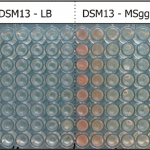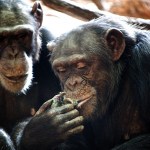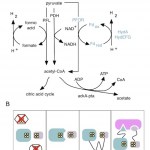research blogging
Cells permanently change their behavior in response to temporary changes to the environment, a kind of biological memory that controls processes as important and complex as how stem cells differentiate into specific tissues or how the immune system "remembers" dangerous pathogens. At its simplest, cellular memory is achieved with a positive feedback loop--once activated by some external signal, the feedback loop will continually activate itself, even as the cell divides and the signal is taken away. In synthetic biology we can recreate such simple feedback loops, genetic circuits built of…
One organism's trash is another organism's treasure. Our cellular wastes, carbon dioxide and water, nourish plants, which with added energy from sunlight produce the oxygen and sugars that we need to survive. At microscopic scales, these cycles of waste and food can get much more complicated, with many species of microbes working together to survive in harsh environments with limited nutrients.
When organisms (like us) digest sugars made of carbon (C), hydrogen (H), and oxygen (O), they split them up into carbon dioxide (CO2), hydrogen ions (H+) and high-energy electrons (e-) that were…
Evolution connects all living things on earth, from the arsenic tolerant bacteria in the news this week to the human scientists and bloggers chatting about it. Eyes are intricately complex structures made up of many many cells, but even single-celled microbes can sense and respond to light through the function of proteins that share evolutionary similarity with the light receptors of the human retina. Incredibly, genetic engineering is showing us just how similar these proteins can be--transferring the genes that code for these processes leads to functional proteins, even when huge…
Mammalian cells need something to hold on to before they can stick to each other and form tissues. The plastic dishes that cells grow on in the lab need to be first coated with special chemicals that grab the cells and convince them to stick. Once the first batch of cells is down they start forming their own matrix of proteins and fibers that can grab new cells as they are formed, slowly creating a dense layer of cells. Tissue engineering aims to make three dimensional, biodegradable scaffolds that cultured cells can grow on to form body parts, like the ear-shaped bit of cow cartilage that…
My good friend and labmate just published an awesome paper: "Emergent cooperation in microbial metabolism." His experiment started with 46 strains of E. coli that had mutations in their metabolic pathways that prevented them from being able to grow without supplementing the media with extra metabolites. Alone they died, but grown together in the same tube, many pairs of mutants were able to feed each other the missing metabolite. Metabolic cooperation was the key to survival.
Measuring and understanding metabolic cooperation can be used to build stronger, more predictive models of…
Cells are constantly jibber jabbering, sending messages to each other to coordinate behavior, both within a population of single-celled organisms or between cells of an individual multicellular organism. Most of these signals are chemicals that float around in the liquid that surrounds the cells but there recently has been an increased appreciation for cells' sense of "smell"--how cells respond to chemicals that are present as gasses.
A brand new paper outlines the discovery of "olfaction" in a species of bacteria, Bacillus licheniformis. Trying to save space on a 96 well dish by putting…
Chimpanzees have culture (or not) depending on your definition.Image: Irish Wildcat / Creative Commons
Author's Note: The following is an expansion on my reply to anthropologist Dan Sperber on the PLoS ONE article "Prestige Affects Cultural Learning in Chimpanzees."
Culture is like art or pornography, it's hard for people to define but everyone knows it when they see it. Cultural anthropologists have long struggled to develop a consistent definition of the very thing that they study, a problem that has resulted in bitter arguments between scholars that, to an outsider, may seem as esoteric…
New research finds chimpanzees follow prestigious models when learning new tasks. Monika Thorpe / Creative CommonsIf one were to play psychiatrist to the natural world, most human beings would be committed for our certifiable obsession with other peoples' behavior. We compulsively examine, study, appraise, size up, and scope out what those around us are doing and then gossip with others about what we've seen or heard. New ideas or behaviors are especially compelling and will often have cultural critics discussing them at length, whether they're tribal elders or the United…
Author's Note: This post was selected as the topic for the ResearchBlogCast as part of ResearchBlogging.org. Listen to the discussion here.
Could punishing bad behavior be the origin of human cooperation?Humans are one of the most cooperative species on the planet. Our ability to coordinate behavior and work collaboratively with others has allowed us to create the natural world's largest and most densely populated societies, outside of deep sea microbial mats and a few Hymenoptera mega-colonies.
A key problem when trying to understand the evolution of cooperation has…
As many of you probably know, when I am not working in the lab or posting here at Obesity Panacea I am also a content editor at ResearchBlogging.org. Each weekday a different Research Blogging editor selects their favourite posts from the past week in their area of expertise, and you can find my favourite posts on Health and Clinical Research here every Wednesday. Since there are always great Health-related posts on Research Blogging that don't necessarily overlap with obesity/fitness/nutrition, I don't usually cross-post my Research Blogging selections here on Obesity Panacea. But this…
A new study shows that chimps sacrifice their own advantage if they earned it unfairly.Image: Owen Booth / Creative Commons
Fairness is the basis of the social contract. As citizens we expect that when we contribute our fair share we should receive our just reward. When social benefits are handed out unequally or when prior agreements are not honored it represents a breach of trust. Based on this, Americans were justifiably outraged when, not just one, but two administrations bailed out the wealthiest institutions in the country while tens of thousands of homeowners (many of whom were…
Culture defines who we are but few can explain where it comes from or why we adopt one tradition over another. In the classic musical The Fiddler on the Roof the main character, Tevye, muses on this basic fact of human existence:
Here in Anatevka we have traditions for everything... how to eat, how to sleep, even, how to wear clothes. For instance, we always keep our heads covered and always wear a little prayer shawl... This shows our constant devotion to God. You may ask, how did this tradition start? I'll tell you - I don't know.
The origin of particular cultural traits in human…
Image: The Daffodil Cichlid of Lake Tanganyika / Koen Eeckhoudt
In 1888 "Darwin's Bulldog", Thomas Henry Huxley, declared that nature was little more than a "gladiator's show" whereby only "the strongest, the swiftest, and the cunningest live to fight another day." Brutal competition was the only important factor in the natural world, in which a "Hobbesian war of each against all was the normal state of existence." As such, we shouldn't expect cooperation in nature because only strength and selfishness is rewarded by evolution.
But a paper by Dik Heg and colleagues, entitled Helpful Female…
Carboxysomes are small compartments inside photosynthetic bacteria where the machinery for capturing carbon dioxide is concentrated. You can see carboxysomes and their characteristic virus-like shape when you look at slices of these bacteria under an electron microscope:
Until recently, no one had looked at carboxysomes under the microscope in cells that were still alive. My labmates Dave and Bruno developed a way to label carboxysomes with fluorescent proteins and track them under a microscope as the cells grow, and their amazing paper in Science details some of the fascinating systems they…
Coca-Cola sucks India dry. Image: Carlos Latuff / Wikimedia CommonsThe marketing executive who came up with Coca-Cola's popular slogan in 1908 most likely never expected it would be taken so literally. However, a hundred years ago there probably weren't many who imagined a term like "water wars" could exist in a region that experiences annual monsoons.
On February 25 a complaint was filed in the New York Supreme Court against the The Coca-Cola Company alleging that they knew about and sought to cover up human rights abuses in Guatemala. While that trial gets started,…
It is a common argument by those who are opposed to evolution's implication for religious belief to label Darwin as a social Darwinist and a racist. Adrian Desmond and James Moore's book Darwin's Sacred Cause has gone a long way towards dispelling any claims that Darwin sought to justify black inferiority (in fact, as they show, countering such arguments was an important part of Darwin's work). However, the claim that Darwin inspired social Darwinism is a persistent argument and those that proffer it will stoop to any level in order to discredit him. As I pointed out in my series…
My paper, "Insulation of a synthetic hydrogen metabolism circuit in bacteria" just came out in the Journal of Biological Engineering! And it's open access!
We designed a metabolic circuit in bacteria that produces hydrogen (a potentially useful fuel) from natural precursors in the cell. The proteins in our synthetic pathway work to make hydrogen by transferring high-energy electrons from pyruvate, a common metabolite, to protons that are freely floating in the watery cytoplasm. The electrons transfer between the proteins through quantum-mechanical tunneling, which makes hydrogenases and…
Artist rendering of Darwinius. Image: Julius T. CsotonyiLast year's publication of the fossil primate Darwinius masillae claimed it to be the oldest haplorhine primate ever discovered and a multimedia blitz campaign touted the find as the ultimate "missing link" (an erroneous term that should forthwith be forbidden to all science journalists). Brian Switek at Laelaps (who has an excellent review of this paper) made headlines for challenging the way that this fossil primate was rushed to market, and it seems that his concerns were more than justified.
According to Brian's Op-Ed…
The finalists have been chosen in the first annual Research Blogging Awards for material written about peer-reviewed literature. Some of my favorite bloggers have been selected including Neurophilosophy, Laelaps, Not Exactly Rocket Science, A Blog Around the Clock (BoraZ also has the best Twitterer category locked in), Skulls in the Stars, Observations of a Nerd, Mauka to Makai, The Scientific Activist, and A Primate of Modern Aspect.
The Primate Diaries has also been selected in the categories of Research Blog of the Year and Blog Post of the year for my piece: "Does Taking Birth Control…
Almost every living thing shares an identical genetic code, with three nucleic acids in an RNA sequence coding for a single amino acid in the translated protein sequence. While there are 64 three-letter RNA sequences, there are only 20 amino acids and degeneracy in the code allows some amino acids to be coded by multiple codons. Chemists and synthetic biologists in the past few years have been working to expand this genetic code, with unnatural nucleotides that can be incorporated into DNA and RNA sequences and unnatural amino acids that can expand the chemical functionality of proteins.…













